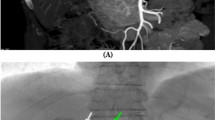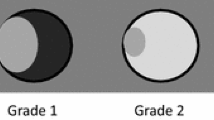Abstract
Background
Changes in the relative arterial flow to hepatocellular carcinomas and adjacent normal liver with hepatic arterial epinephrine infusion were studied with CT hepatic arteriography (CTHA).
Methods
Data from 31 pathologically confirmed hepatocellular carcinomas were retrospectively analyzed in 16 patients who simultaneously underwent CT during arterial portography (CTAP) and CTHA for examination of liver tumors and then CTHA with hepatic arterial epinephrine infusion.
Results
Regarding visual analysis, tumor enhancement of hepatocellular carcinomas on CTHA after hepatic arterial epinephrine injection changed as follows: more clear in 83.9% (26/31), equal in 16.1% (5/31), and less clear in 0% (0/31). As for the quantitative analysis, CT attenuation value of hepatocellular carcinomas significantly increased after injection of epinephrine (mean increase from 225.8 to 333.9 HU; P < 0.0001, paired t test). The CT attenuation value of normal liver parenchyma around a tumor significantly decreased after injection of epinephrine (mean decrease from 101.1 to 84.6 HU; P < 0.0001, paired t test). The tumor-to-liver conspicuity significantly increased after injection of epinephrine (mean increase from 124.6 to 249.2 HU; P < 0.0001, paired t test).
Conclusions
Hepatic arterial epinephrine infusion changes the relative arterial flow of hepatocellular carcinomas.




Similar content being viewed by others
References
Abrams HL, Boijsen E, Borgström KE, et al. (1962) Effect of epinephrine on the renal circulation. Radiology 79:911–922
Abrams HL (1964) The response of neoplastic renal vessels to epinephrine in man. Radiology 82:217–224
Boijsen E, Redman H (1967) Effect of epinephrine on celiac and superior mesenteric angiography. Invest Radiol 2:184–199
Macgregor AC, Hawkins IF Jr (1973) Selective pharmacodynamic angiography in the diagnosis of carcinoma of the pancreas. Surg Gynecol Obstet 137:917–921
Mills SR, Doppman JL, Kahn ER, et al. (1979) Metastatic islet cell carcinoma to liver visualized intraarterial epinephrine. AJR Am J Roentgenol 132:664–665
Ackerman NB, Hechmer PA (1980) The blood supply of experimental liver metastases. V. Increased tumor perfusion with epinephrine. Am J Surg 140:625–631
Ackerman NB, Jacobs R, Bloom ND, et al. (1988) Increased capillary flow in intrahepatic tumors due to α-adrenergic effects of catecholamines. Cancer 61:1550–1554
Andrews JC, Walker-Andrews SC, Juni JE, et al. (1989) Modulation of liver tumor blood flow with hepatic arterial epinephrine: a SPECT study. Radiology 173:645–647
Kanematsu M, Hoshi H, Imaeda T, et al. (1997) Detection and characterization of hepatic tumors: value of combined helical CT hepatic arteriography and CT during arterial portography. AJR Am J Roentgenol 168:1193–1198
Murakami T, Oi H, Hori M, et al. (1997) Helical CT during arterial portography and hepatic arteriography for detecting hypervascular hepatocellular carcinoma. AJR Am J Roentgenol 169:131–135
Inoue E, Fujita M, Hosomi N, et al. (1998) Double phase CT arteriography of the whole liver in the evaluation of hepatic tumors. J Comput Assist Tomogr 22:64–68
Kim HC, Kim TK, Sung KB, et al. (2003) Preoperative evaluation of hepatocellular carcinoma: combined use of CT with arterial portography and hepatic arteriography. AJR Am J Roentgenol 180:1593–1599
Yamagami T, Nakamura T, Kin Y, et al. (2000) Non-tumorous enhancement caused by cholecystic venous inflow shown on biphasic CT hepatic arteriography: comparison with hepatocellular carcinoma. Br J Radiol 73:1275–1281
Yamagami T, Nakamura T, Iida S, et al. (2002) Effects of prostaglandin E1 injection through the superior mesenteric artery on the hemodynamics of hepatocellular carcinoma. AJR Am J Roentgenol 178:349–352
Murakami T, Kim T, Takamura M, et al. (2001) Hypervascular hepatocellular carcinoma: detection with double arterial phase multi-detector row helical CT. Radiology 218:763–767
Mori K, Yoshioka H, Takahashi N, et al. (2005) Triple arterial phase dynamic MRI with sensitivity encoding for hypervascular hepatocellular carcinoma: comparison of the diagnostic accuracy among the early, middle, late and whole triple arterial phase imaging. AJR Am J Roentgenol 184:63–69
Yoshioka H, Takahashi N, Yamaguchi M, et al. (2002) Double arterial phase dynamic MRI with sensitivity encoding for hypervascular hepatocellular carcinomas. J Magn Reson Imaging 16:259–266
Muller RD, Vogel K, Neumann K, et al. (1999) SPIO-MR imaging versus double-phase spiral CT in detecting malignant lesions of the liver. Acta Radiol 40:628–635
Kwak HS, Lee JM, Kim CS (2004) Preoperative detection of hepatocellular carcinoma: comparison of combined contrast-enhanced MR imaging and combined CT during arterial portography and CT hepatic arteriography. Eur Radiol 14:447–457
Mattsson J, Appelgren L, Hamberger B (1977) Adrenergic innervation of tumors blood vessels. Cancer Lett 3:347–351
Hafström L, Norbin A, Persson B, et al. (1980) Effects of catecholamines on cardiovascular response and blood flow distribution to normal tissue and liver tumors in rats. Cancer Res 40:481–485
Ashraf S, Crowe R, Loizidou MC, et al. (1996) The absence of autonomic perivascular nerves in human colorectal liver metastases. Br J Cancer 73:349–359
Suzuki M, Takahashi T, Sato T (1987) Medial regression and its functional significance in tumor-supplying host arteries. A morphometric study of hepatic arteries in human livers with hepatocellular carcinoma. Cancer 59:444–450
Yamada R, Sato M, Kawabata M, et al. (1983) Hepatic artery embolization in 120 patients with unresectable hepatoma. Radiology 148:397–401
Nakamura H, Hashimoto T, Oi H (1989) Transcatheter oily chemoembolization of hepatocellular carcinoma. Radiology 170:783–786
Hamada A, Yamakado K, Nakatsuka A, et al. (2004) Hepatic arterial infusion chemotherapy with use of an implanted port system in patients with advanced hepatocellular carcinoma: prognostic factors. J Vasc Interv Radiol 15:835–841
Sumie S, Yamashita F, Ando E, et al. (2003) Interventional radiology for advanced hepatocellular carcinoma: comparison of hepatic artery infusion chemotherapy and transcatheter arterial lipiodol chemoembolization. AJR Am J Roentgenol 181:1327–1334
Ando E, Tanaka M, Yamashita F, et al. (2002) Hepatic arterial infusion chemotherapy for advanced hepatocellular carcinoma with portal vein tumor thrombosis: analysis of 48 cases. Cancer 95:588–595
Chung YH, Song IH, Song BC, et al. (2000) Combined therapy consisting of intraarterial cisplatin infusion and systemic interferon-α for hepatocellular carcinoma patients with major portal vein thrombosis or distant metastasis. Cancer 88:1986–1991
Seno H, Ito K, Kojima K, et al. (1999) Efficacy of an implanted drug delivery system for advanced hepatocellular carcinoma using 5-fluorouracil, epirubicin and mitomycin C. J Gastroenterol Hepatol 14:811–186
Minoyama A, Yoshikawa M, Ebara M, et al. (1995) Study of repeated arterial infusion chemotherapy with a subcutaneously implanted reservoir for advanced hepatocellular carcinoma. J Gastroenterol 30:356–366
Itai Y, Matsui O (1997) Blood flow and liver imaging. Radiology 202:306–314
Nagino M, Nimura Y, Kamiya J, et al. (1998) Immediate increase in arterial blood flow in embolized hepatic segments after portal vein embolization: CT demonstration. AJR Am J Roentgenol 171:1037–1039
Author information
Authors and Affiliations
Corresponding author
Rights and permissions
About this article
Cite this article
Tanaka, O., Yamagami, T., Kato, T. et al. Epinephrine-infused CTHA for HCCs. Abdom Imaging 33, 308–312 (2008). https://doi.org/10.1007/s00261-007-9232-2
Published:
Issue Date:
DOI: https://doi.org/10.1007/s00261-007-9232-2




